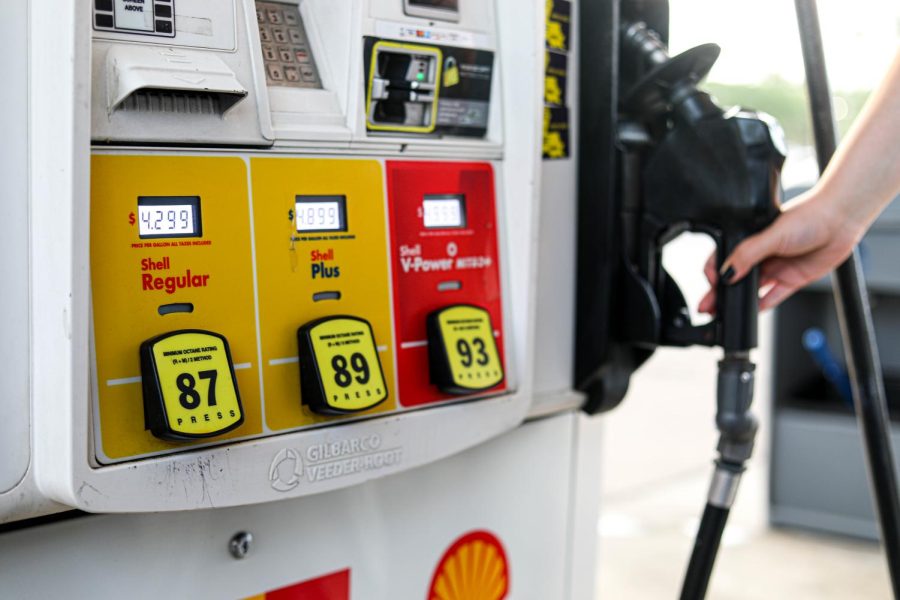Community reacts to gas prices
Photo Illustration
April 8, 2022
Matt Gantt has seen many things during his six years as an Uber driver. Paying up to $200 for a week’s worth of gas? That’s a new one—until now.
Today, gas prices are reaching record highs across the country. Gantt, a Syracuse, New York native drives for up to six hours a day and six days a week, paying $4.19 a gallon out-of-pocket to fill his Hyundai Sonata.
“It’s more than what we should be paying,” Gantt said.
Like Gantt, members of the Loyola community are struggling with paying more at the pump. The current average price of gas in New Orleans is $4.03, which is nearly 1.6 times the average price compared to last year.
Business analytics and economics professor John Levendis attributes the rise in gas prices to people returning to work.
“First, we’re getting out of this (COVID-19) recession, so everyone is working. We used to be commuting from home via Zoom, which doesn’t take any gas at all,” Levendis said. “Now, people have got to get back and forth to work a whole lot more than before, so the demand for gas is increasing. Everyone needs gasoline.”
The world is also adjusting to changes because of the ongoing war between Russia and Ukraine.
“At the same time, we’ve got this geopolitical event going on, so it’s harder to get the gas,” Levendis said. “It’s kind of a double whammy. We’ve got increasing demand and decreasing supply, so prices are just skyrocketing.”
Rising prices are affecting strategic communications senior Brittany Prats. She lives in Mandeville, Louisiana, which is a 40-minute drive to Loyola. She also works in Kenner, Louisiana, which is 40 minutes away from Mandeville. As she’s required to be on campus at least four days a week, Prats said she is annoyed about having to pay higher prices for gas.
“I’m having to fill up once or twice a week, so it’s almost $100 every week out of my paycheck,” she said. “A majority of my paycheck is going to that.”
Paying more for gas has also forced Prats to pick and choose when she can and can’t go to an event.
“It’s caused me to not go to some on-campus events that I wanted to go to because I don’t want to waste the money on gas,” Prats said.
Jeffrey Albert, associate professor and director of the School of Music Industry and the School of Music and Theatre Arts at Loyola, also has a daily 45-minute commute to Loyola from Mandeville. Unlike Prats, Albert said the rise in gas prices hasn’t hurt his wallet so much.
“It hasn’t hit me as hard as some other people because as long as I’ve been doing this commute, I’ve been trying to drive something that gets good mileage,” he said.
Albert paid around $30 the last time he got gas on March 31, an increase from the $18 to $20 he’s used to spending to fill his tank. His Prius gets about 60 miles per gallon, and he said that one round-trip commute from work to his home is about 70 miles.
“It’s only gone from costing me a couple of dollars a trip to $3 or $4 a trip, which isn’t so bad,” Albert said. “I’m lucky in my nerdy fuel-efficient car choice, for sure.”
However, Albert pays closer attention to which gas stations he goes to now that he’s paying more money.
“I used to always stop at whatever gas station was closest to me. Now, as I see the tank going down, I’m looking around thinking, ‘It’s a little cheaper over there. Maybe I’ll stop at that one instead of this one,’” he said.
Levendis recommended that people ride bicycles, carpool, and minimize trips to the grocery store or places of entertainment as temporary money-saving techniques.
“That takes a little bit of the edge off, but it’s not enough,” Levendis said. “I think it’s going to be a long time before prices normalize for gas.”









